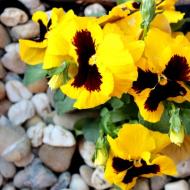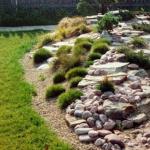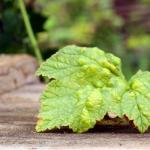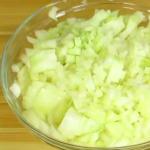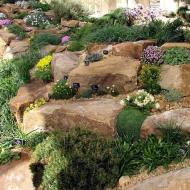
How to make an alpine slide in the country with your own hands: step by step instructions
Alpine Hill is a small rock garden, it is an indispensable attribute of landscape design of large plots of land, and is also quite suitable for creating picturesque compositions on summer cottages of six acres.
Choosing a site for rock garden
A sunny, ventilated place is very suitable for an alpine slide. The site must be clearly visible from a distance. If the alpine hill is located so that the main slope is on the east or southeast side, then it is best to plant mountain plants. If the slope is facing south, then plants that love direct sunlight will feel good.
If there are natural natural irregularities on the site, then this is always a plus in creating a rock garden. The site does not require alignment and unevenness can be successfully decorated as a rock garden. If the site is flat, then elevations can be created if desired.
Alpine slide device
The rock garden area should be in harmony with its height. In order not to complicate the care of the slide, it should not exceed a height of two meters. The best option for a slide in the garden is a height of 50 to 80 centimeters and an area of 6 to 10 square meters. Ideally, arrange an alpine slide on a slope of 15 degrees, but if there is none, you can create an bulk one.

Territory preparation
From the territory prepared under the hill, a layer of soil is removed by 20 centimeters, while all weeds are selected. After that, a drainage layer is laid out on the prepared site, it may well be broken brick, crushed stone or slag. Drainage is needed in order to avoid stagnant water and rotting of plant roots. The drainage is heavily compacted. On clay soil and wet ground, drainage should reach 30 cm and, accordingly, the depth of removal of the soil layer also increases.
Next, the actual slide of the desired height and shape is formed. Fragments of bricks, rubble, earth left from under the foundation are laid on the drainage. Sometimes construction debris is used, but many landscapers are against it.
On top of the prepared form of the hill, a fertile layer of earth is laid, at least twenty centimeters thick. If there is a lot of clay on the site, then the soil is diluted with sand and peat, if the soil is rich in sand, then, on the contrary, it is necessary to dilute it with loam. Then mineral fertilizers mixed with the soil are applied. A fertile layer with removed weeds is laid over the entire surface of the rock garden.
Advice!Some landscapers recommend not fertilizing the entire surface of the hill so that the plants do not grow too much. For unpretentious rock plants, a mixture of a fertile layer with peat is quite suitable, but for growing exotics, it is necessary to prepare a special mixture.
Stone laying

After the main preparatory work for the construction of the slide is completed, you can begin to lay out the stones. To prevent weeds from growing, pieces of plastic film are placed under the stones, in which holes are cut for water drainage. The stones are laid out parallel to the surface of the slide, while monotonous stones should be avoided in order to maintain the natural attractiveness of the landscape. If the rock garden is large, then the stones for the base are taken large, laid out at intervals.
The stones should be of the same color, ideally if they have the same structure: limestone, shell rock, dolomite or granite. The laying of stones begins from the base of the hill, the stones are fixed and do not overhang. On the slope, the stones should be positioned so that the water flows from top to bottom and does not stagnate. The space between the stones is covered with soil, it must be suitable for plant life, and be about 10 square centimeters. The earth around the stones is tightly packed so that they do not sink during the spring flood. The stones should not be set with the tip up, this violates the naturalness of the composition.
Attention:it is correct to place the stones in the ground half or a third, burying them so that the sharp ends and edges are located underground.
The stones in the alpine hill are the background pattern for plants and should form a single composition with them.
Selection and planting of plants for rock garden
For rock garden plants, soil is the main habitat. As a rule, garden soil does not always meet all the requirements of plants, therefore, if everything is done correctly, the soil mixture must be prepared. The composition of the soil for rock garden plants is approximately the following: turf, peat or humus and drainage (screenings, slag, small gravel). All components of the mixture are taken in a ratio of one to one. You can add a handful of bone meal to the mixture. The mixture is poured between the stones and slightly compacted.
You need to try to create conditions for the plants so that they feel comfortable. Not all plants that are recommended for summer alpine slides are mountain ones. Some species come from the steppes; plants of the tundra or mountain desert look great on a hill. On a small piece of land, if you take this seriously, you need to arrange a suitable microclimate for the plants.
bulbous perennials
 Plants native to Asian deserts, such as bulbs, are often grown on alpine slides. At home, with the advent of spring, such plants bloom early, delight the eye during the spring month, and then they need to warm the bulbs in hot sand until the next flowering season. For example, bulbous perennial flowers such as crocuses will fit perfectly into the rock garden landscape. They bloom with the onset of thawed snow and, depending on the variety, delight gardeners from April to June. Well suited for alpine slides, as well as for rockeries, fritillaria "chess" or, in Russian, hazel grouse. These flowers are low, begin to bloom in early spring and look very beautiful in rock gardens against the background of small bushes.
Plants native to Asian deserts, such as bulbs, are often grown on alpine slides. At home, with the advent of spring, such plants bloom early, delight the eye during the spring month, and then they need to warm the bulbs in hot sand until the next flowering season. For example, bulbous perennial flowers such as crocuses will fit perfectly into the rock garden landscape. They bloom with the onset of thawed snow and, depending on the variety, delight gardeners from April to June. Well suited for alpine slides, as well as for rockeries, fritillaria "chess" or, in Russian, hazel grouse. These flowers are low, begin to bloom in early spring and look very beautiful in rock gardens against the background of small bushes.
Coniferous dwarf plants
 In the rock garden, you can grow both shrubs and conifers, but, nevertheless, these should be their dwarf species. It looks very beautiful all year round and fits perfectly into the design of the alpine hill dwarf mountain pine. Junipers are also grown on alpine hills, undersized, pyramidal or creeping, ground cover. The miniature spruce Piceaglauca "Echiniformis", 30 cm high, with short silvery needles, looks very beautiful and exotic in the rock garden, and there are also dwarf firs and cypresses that add exoticism and naturalness to the landscape design of the rock garden.
In the rock garden, you can grow both shrubs and conifers, but, nevertheless, these should be their dwarf species. It looks very beautiful all year round and fits perfectly into the design of the alpine hill dwarf mountain pine. Junipers are also grown on alpine hills, undersized, pyramidal or creeping, ground cover. The miniature spruce Piceaglauca "Echiniformis", 30 cm high, with short silvery needles, looks very beautiful and exotic in the rock garden, and there are also dwarf firs and cypresses that add exoticism and naturalness to the landscape design of the rock garden.
Dryad
 One of the low creeping deciduous species is the dryad. This plant is attractive with leaves, flowers and fruits. Dryad looks very beautiful on the alpine hills. Also used for growing in rock gardens broom with its bright yellow flowers, it has many varieties that differ in color of flowers. The barberry is also beautiful, especially in autumn, when its leaves turn red against the beige shades of the stone garden.
One of the low creeping deciduous species is the dryad. This plant is attractive with leaves, flowers and fruits. Dryad looks very beautiful on the alpine hills. Also used for growing in rock gardens broom with its bright yellow flowers, it has many varieties that differ in color of flowers. The barberry is also beautiful, especially in autumn, when its leaves turn red against the beige shades of the stone garden.
Rhododendrons

They can decorate both large and small rock gardens - these are undersized species, and evergreen, and deciduous.
rock garden care
Warm and sunny days in early spring can encourage gardeners to clean rock gardens. But early harvesting of the cover of dry foliage and needles, especially in sunny weather, can be dangerous: the bright spring sun can burn the roots of some mountain plants, and unexpected frost can damage still fragile leaves and stems. But, for example, early harvesting is not terrible for bulbous, they are frost-resistant. First, the needles are removed, the old foliage is raked out, only after the good weather sets in, the last film shelters are removed, installed in the fall to protect especially capricious plants.
Stones are checked for stability, sagging stones are lifted and soil is sprinkled under them. It is necessary to weed out weeds, cut bushy plants.
If the weather is warm and dry for a long time in the spring, then the rock garden is watered. At the same time, you need to start feeding some plants with mineral fertilizers.
Throughout the summer, during hot and dry weather, the rock garden must be watered, as the stones heat up, the moisture evaporates quickly, and the plants suffer from drought. In autumn, on the contrary, it is unwise to abuse excessive watering in order to avoid overgrowth of plants.

Note:if it was carried out on the site, when arranging an alpine slide, you can stretch pipes to it as well - this way you will make your work easier and create comfortable conditions for the plants.
In perennials, the ovaries are removed, some lush plants are pruned, but not drastically, since they can die in winter.
Early autumn is the time for planting perennial bulbous plants in rock gardens, as well as the time for transplanting many alpine plants.
Plants in rock gardens should not be covered too early. Freezing will help them harden. In damp weather, mold will develop under the shelter.
Even before the onset of frost, the alpine hill is covered with spruce branches, it contributes to the aeration of plants and protects them from frost. For shelters, it is recommended to use fresh branches of spruce or fir. Dry foliage is not suitable for shelter, it is strongly compacted in winter and prevents the penetration of air to the soil, mold develops under it and rodents live.
Some points of safety in the rock garden
Stones in rock gardens should be periodically checked for stability, especially if the family has small children who often climb among the stones. Boulders for an alpine slide are better to use a rounded shape. If the rock garden has steps made of flat sandstone or limestone, then work on the hill is best done in shoes with a flat sole and a rough surface.






